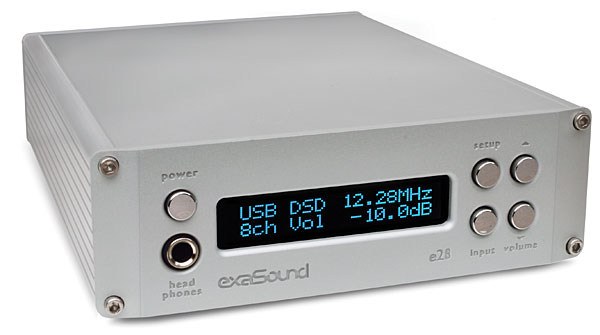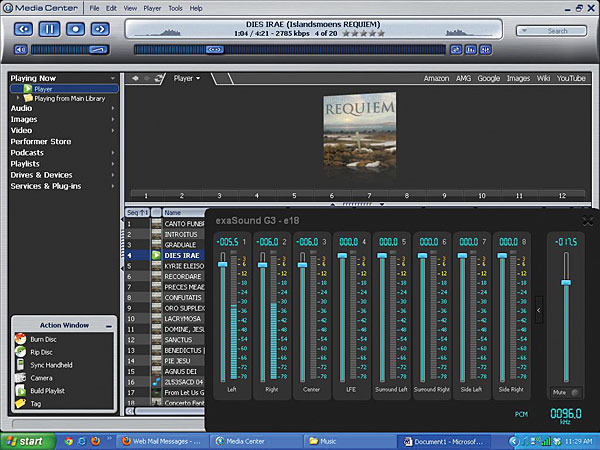| Columns Retired Columns & Blogs |
1) Did George ever lable which cable ( LR, Center etc) goes where in the back of the DAC.
2) How is 2 chl on the e28 as compared to the e20mkIII
Fortunately, the Cirrus chipset in the AVP-18 offers a potent parametric equalizer. This can be extremely effective: each of the 11 filters for the five main channels permits adjustment of frequency (20Hz–20kHz), gain (±12dB), and Q (0.125–24). The three filters in the subwoofer channel are similar, except for frequency (20–300Hz). I was able to transfer filters from XTZPro for just the bass, or from Room EQ Wizard for wider spectrum correction into the NuForce's Manual EQ 1 and Manual EQ 2 setups, and compare them to the NuForce's AutoEQ and so-called Flat (no EQ) options.
Operationally, the NuForce AVP-18 was flawless. Switching among inputs and formats was brisk and silent. The sound quality, if I can generalize from all the setup options, was well balanced across the audioband, and overall resolution and imaging were quite good. After I manually applied the appropriate room/speaker correction, the AVP-18's sound was quite satisfying in all aspects—only the hypercritical among us (the majority, perhaps?) would be bothered by its somewhat shallow, if wide, soundstage, and a loss of richness in the low midrange. Voices always sounded clear and natural, and the bass could not be faulted.
When I compared the NuForce AVP-18 to the Marantz AV8801 (at three times the price), I did hear some harshness and loss of transparency in the midrange, and a bit of tizziness in the extreme treble. I confirmed this by comparing sound files of identical content but varying resolution. Using the AV8801 with Audyssey equalization bypassed, the difference between 16/44.1 and 24/96 was easily audible, and that between 24/96 and 24/192 generally detectable. The AVP-18 passed the first test but failed the second. In an overall context of price, this is really good performance; I thoroughly enjoyed listening to all sorts of music through the NuForce, including hi-rez discs and files via HDMI from the Oppo BDP-103.
In sum, the all-digital NuForce AVP-18 is a good choice for an easy-to-use and easy-to-look-at preamplifier-processor. If you know now, or later decide, that you want analog features, you can add the matching (and similarly priced) MVP-18 and control them both from the same remote. The AVP-18 becomes an even better value for those able to make use of its powerful parametric EQ, which, as far as I know, is unique at its price. Just don't rely on its AutoEQ.
. . . but not too simple
While the simplicity of the NuForce AVP-18 was just fine for the more casual uses to which I put my weekend system in Connecticut, its lack of analog inputs was a problem when it came to using DACs or equalizers. My Manhattan rig has analog inputs, but these are redigitized by that system's central component, the Meridian 861. This was not a fair way to assess the exaSound e28 multichannel DAC and the stacked trio of Mytek Stereo192-DSD DACs (see below), since, as good a job as the Meridian does with its apodizing DACs, its inputs are still limited to 24/96. The solution, of course, is to get a purely analog preamp controller.
I hunted down an Audio Research MP1, which, in addition to its stereo inputs, has three six-channel analog inputs, one of them balanced. I think I was lucky to find it—this product category has all but disappeared, and the ARC MP1, along with the Bel Canto Design Pre6, was the best of all the multichannel preamps I've tried. Not just a way to switch inputs, the MP1 offers Home Theater Bypass, volume and balance control, and, on its multichannel inputs, the ability to adjust individual channel levels for each input. This also permits A/B comparisons without a distracting flurry of cable swaps. Let the fun begin.
exaSound e28 multichannel DAC
In my May 2013 column, I reported on the grand time I had with the first consumer hi-rez multichannel D/A converter, exaSound Audio Design's e18, but lamented that it couldn't handle DSD signals. Designer George Klissarov then provided a firmware update that converted the e18 to Mk.II status and whetted my appetite for more. I asked Klissarov about multichannel DSD firmware more than once, but he said that there soon would be a new DAC, the e28, that would be the performance equivalent of his flagship two-channel DAC, the e20.

Since then, the e20 has been updated to Mk.III status ($2899). Like the new e28 ($3299), it comes with RCA outputs; balanced output via mini-XLRs costs extra. All exaSound DACs have an asynchronous USB input and use the ESS Technology ES9018 Sabre32 DAC chip.. Operationally, the e28 is the same as the e18, and looks the same except for its case, which is about 2.5" deeper. But while the e18 could do DSD only in stereo and at the base sampling rate of 2.82MHz, the e28 can deal with DSD sampling rates of 2.82, 3.072, 5.64, 6.14, 11.28, and 12.28MHz (or DSD 64, 128, 256 (footnote 1) Fs) without converting the signal to PCM. The e28 also adds an enhanced headphone output, and is specified as having lower distortion and noise than its predecessor in every measured mode.
I installed the new exaSound software on my PC-based server and, after opening JRiver Media Center 18, the two- and eight-channel exaSound drivers were available under the Output Settings. Also, exaSound's G3 user interface appeared in my PC's Task Bar for easy pop-up. This tool is quite useful; it permits level adjustment for each channel, as well as for overall gain; JRiver and almost all such software won't perform level adjustments on DSD without first converting it to PCM. G3 will also let you connect the e28 directly to a power amplifier. Klissarov recommends this option, to avoid the lossy digital attenuation and conversion to PCM of pre-pros, and the potential noise and distortion of an analog preamp. The G3 interface sends commands to the e28's ESS-9018 chip to attenuate the signal prior to the DAC section. The philosophy is nicely explained here, but it is clearly a PCM-framed argument rather than a 1-bit explanation.

For general convenience and the ability to compare the e28 with other DACs, I connected it via my Audio Research MP1 preamp controller. When I attached the exaSound directly to my power amps, the sound was absolutely pristine, but given how long it took to change from this back to using the MP1, I can't say it was any better, or even different.
Nonetheless, the e28 was a delight to listen to with every source format, from 16/44.1 stereo through 24/192 PCM, 352.8kHz DXD, multichannel DSD64, and even stereo DSD 256! At these levels of quality it's hard to dissect the sound, but I consistently noticed how sweetly and purely the e28 rendered violin tone while preserving the edginess of bows dragged across the strings. Voices and instruments seemed to have a realistically defined presence wherever in the soundstage they were placed, and balances remained smooth right down to the bottom of the audioband.
A program of Sibelius's theater music, with Joseph Swenson conducting the Scottish Chamber Orchestra (24/96 FLAC, Linn CKD 220), has always been a go-to for the beauty of the string tone, but the bass drum in Belshazzar's Feast had a fullness that was new. Similarly, Channel Classics' DSD session files of Iván Fischer and the Budapest Festival Orchestra's recordings of Mahler's Symphonies 1 and 5 were just a bit more spacious, with a very generous dynamic range. Moving on to more exotic formats, a free download of a stereo DSD128 file from Opus3 of Eric Bibb had remarkable presence and impact, and 352.kHz DXD downloads from 2L of string quartets by Haydn and Schubert were breathtaking in their clarity. But the piäce de résistance was a stereo DSD256 (11.2896MHz!) of a Paganini violin solo made by the 1-bit Audio Consortium, a Japanese group promoting 1-bit recording at very high resolutions. I hate to use the overworked palpability, but I can't think of any other word that so well describes the effect.
But is increasing resolution all there is to good sound? Of course not: All my plain old 16/44.1 files sounded great through the exaSound e28. They did equally well through the Mytek DAC trio, which held their own against the e28—anyone would be fortunate to have either DAC setup in their multichannel system. In carefully level-matched comparisons, I felt the Myteks sounded more detailed, which benefited multichannel recordings whose ambience was a bit excessive, while not distorting the balances of better recordings. The e28 was a bit softer in the upper mids and treble, but not at all lacking in resolution or detail. Recordings with too much bloom still sounded a bit congested through the e28, but that's what they are.
Based only on what I hear, I have a small but decided preference for the exaSound over the Myteks. This choice is bolstered by a number of factors. The Mytek trio is saddled with some practical disadvantages, including the inconvenience of fiddling with the controls of multiple DACs, their interconnections with a USB hub and three clock links, the inability to handle DXD or DSD256 (as if there were any number of recordings to speak of available in those formats), and by a higher price. After all, the Mytek array was really just a demonstration of a proof of principle, and a successful one. The exaSound e28 is a real-world, second-generation, cutting-edge, multichannel (!) DAC. I wouldn't hold my breath waiting for something better to come along any time soon.
Coming around in the Round
More complexity, in the forms of two unusual products. First, the Immersive Audio Processor, from Swiss company Illusonic, promises to expand surround listening for a myriad of formats. Second will be a processor from miniDSP, the 10x10HD, which promises to bring us powerful multichannel room equalization at an unprecedentedly low price.

1) Did George ever lable which cable ( LR, Center etc) goes where in the back of the DAC.
2) How is 2 chl on the e28 as compared to the e20mkIII

No, he never did but it is as follows:
1,2: Left Front, Right Front
3,4: Center, Subwoofer
5,6: Left Surround, Right Surround
I have not tried the e20 but the e28 is quieter than the e18 and, of course, it sounds as good through 2 channels.